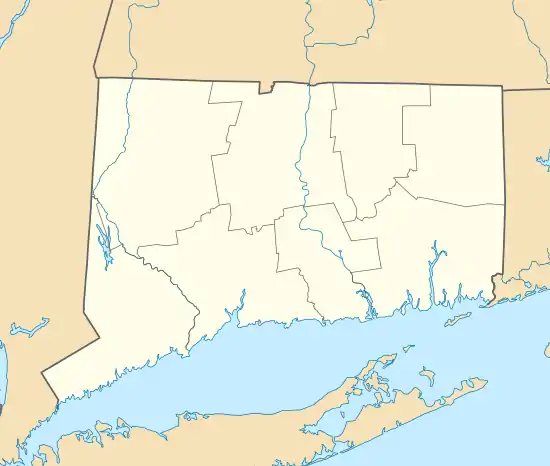Roseland Cottage
Roseland Cottage, also known as Henry C. Bowen House or as Bowen Cottage, is a historic house located on Route 169 in Woodstock, Connecticut. The house was added to the National Register of Historic Places in 1977, and was declared a National Historic Landmark in 1992. It is described as one of the best-preserved and best-documented Gothic summer houses in the nation, with virtually intact interior decorations.[2][3]
_-_entryway.jpg.webp)
Henry C. Bowen House | |
Roseland Cottage | |
  | |
| Location | 556 Route 169, Woodstock, Connecticut |
|---|---|
| Coordinates | 41°56′56.72″N 71°58′36.64″W |
| Built | 1846 |
| Architect | Joseph Collins Wells; Edwin Eaton |
| Architectural style | Gothic Revival |
| Part of | Woodstock Hill Historic District (ID98001578) |
| NRHP reference No. | 77001414 |
| Significant dates | |
| Added to NRHP | August 24, 1977[1] |
| Designated NHL | October 5, 1992[2] |
| Designated CP | January 6, 1999 |
_-_interior_view.jpg.webp)
It is now owned by Historic New England, a non-profit organization that preserves the historical value of the house and operates it as a museum.
Roseland Cottage was built in 1846 in the Gothic Revival style as the summer home of Henry Chandler Bowen and family. The entire complex, with a boxwood parterre garden, an icehouse, garden house, carriage barn, and the nation's oldest surviving indoor bowling alley, reflects the principles of writer and designer Andrew Jackson Downing. In his widely popular books, Downing stressed practicality along with the picturesque, and offered detailed instructions on room function, sanitation, and landscaping.
Beginning in 1870, the largest Fourth of July celebrations in the United States were held at Roseland Cottage. Four United States Presidents visited Bowen's summer home as his guests and speakers for these celebrations: Ulysses S. Grant, Benjamin Harrison, Rutherford B. Hayes, and William McKinley. Other prominent visitors included Henry Ward Beecher, Julia Ward Howe, Oliver Wendell Holmes and John C. Fremont.[4]
Today the house remains in excellent historic condition, with original Gothic furniture and embossed Lincrusta Walton wall decoration. The house, known locally as The Pink House, is currently painted coral pink, and located on Woodstock Hill Common. Roseland's parterre garden contain twenty-one flowerbeds with more than 4,000 annuals bordered in boxwood, in their original 1850 pattern, and now form part of Connecticut's Historic Gardens.
The house is a contributing property within NRHP-listed Woodstock Hill Historic District.[5]
See also
References
- "National Register Information System". National Register of Historic Places. National Park Service. January 23, 2007.
- "Henry C. Bowen House". National Historic Landmark summary listing. National Park Service. Archived from the original on 2007-10-09. Retrieved 2007-10-03.
- Anne Andrus Grady (November 1, 1991). "National Historic Landmark Nomination: Henry C. Bowen House (Roseland Cottage)" (pdf). National Park Service. Cite journal requires
|journal=(help) and Accompanying 7 photos, exterior and interior, from c.1977, 1986, 1989 and undated. (1.90 MB) - "A Brief History of Woodstock" Web page on the Woodstock, Connecticut official town Web site, accessed July 30, 2006
- Bruce Clouette and Hoang Tinh (September 8, 1997). "National Register of Historic Places Inventory/Nomination: Woodstock Hill Historic District". National Park Service. and accompanying photos
External links
| Wikimedia Commons has media related to Roseland Cottage. |
- Historic New England website
- Historic American Buildings Survey (Library of Congress) - Bowen Cottage
